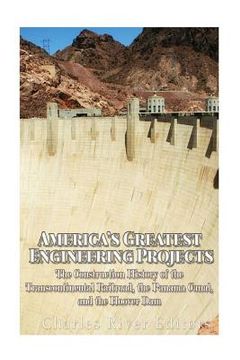America's Greatest Engineering Projects: The Construction History of the Transcontinental Railroad, the Panama Canal, and the Hoover Dam (in English)
Synopsis "America's Greatest Engineering Projects: The Construction History of the Transcontinental Railroad, the Panama Canal, and the Hoover Dam (in English)"
*Includes pictures *Includes accounts of the projects' construction *Includes online resources and a bibliography for further reading The Transcontinental Railroad, laid across the United States during the 1860s, remains the very epitome of contradiction. On the one hand, it was a triumph of engineering skills over thousands of miles of rough terrain, but on the other hand, it drained the natural resources in those places nearly dry. It "civilized" the American West by making it easier for women and children to travel there, but it dispossessed Native American civilizations that had lived there for generations. It made the careers of many men and destroyed the lives from many others. It was bold and careless, ingenious and cruel, gentle and violent, and it enriched some and bankrupted others. In short, it was the best and worst of 19th century America in action. Of course, even once a route was chosen, the backbreaking work itself had to be done to connect railroad lines across the span of nearly 2,000 miles. This required an incredible amount of manpower, often consisting of unskilled laborers engaging in dangerous work, and the financial resources poured into it were also extreme. In a world where few natural rivers carved out over eons of time have reached a length of more than 50 miles, the idea that a group of men could carve a canal of that length seemed impossible. In fact, many thought it could not be done. On the other hand, there was a tremendous motivation to try, because if a canal could be successfully cut across Central America to connect the Atlantic and Pacific Oceans, it would cut weeks off the time necessary to carry goods by sea from the well-established East Coast of the United States to the burgeoning West Coast. Moreover, traveling around the tip of South America was fraught with danger, and European explorers and settlers had proposed building a canal in Panama or Nicaragua several centuries before the Panama Canal was actually built. Building the Panama Canal was a herculean task in every sense. Taking about 10 years to build, workers had to excavate millions of cubic yards of earth and fight off hordes of insects to make Roosevelt's vision a reality. Roosevelt also had to tie up the U.S. Navy in a revolt in Colombia to ensure Panama could become independent and thus ensure America had control of the canal. During the 1930s, at the height of the Great Depression, thousands of workers began work on the Hoover Dam, built in the Black Canyon, which had been cut by the powerful Colorado River. The Colorado River was responsible for the Grand Canyon, and by the 20th century, the idea of damming the river and creating an artificial lake was being explored for all of its potential, including hydroelectric power and irrigation. By the time the project was proposed in the 1920s, the contractors vowing to build it were facing the challenge of building the largest dam the world had ever known. As if that wasn't enough, the landscape was completely unforgiving. The engineering that went into the Hoover Dam was not just dangerous but unprecedented, to the extent that the Hoover Dam relied on building methods that had never been proven effective on such a giant scale. The project also had to employ tens of thousands of people in often dangerous working conditions, which resulted in scores of deaths. At the same time, however, the large number of men that traveled to work on the project helped turn Las Vegas, a nearby small desert town in Nevada, into Sin City. America's Greatest Engineering Projects: The Construction History of the Transcontinental Railroad, the Panama Canal, and the Hoover Dam chronicles the construction of each major project, and their subsequent history. Along with pictures of important people, places, and events, you will learn about the Transcontinental Railroad, Panama Canal, and Hoover Dam like never before.

